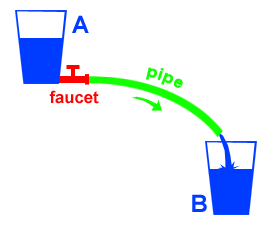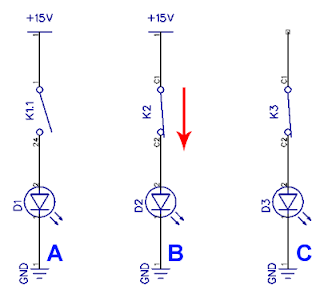
To understand the voltage and ampere we can see the example of two glasses are placed in different positions (left image). Glass "A" at the top position and glass "B" in the lower position. Glass "A" and glass "B" is connected with the pipe and in glass "A" attached faucet and filled with some water.
If the faucet is opened, the water will flows from glass "A" to the glass "B" through the pipe. The amount of water current that flows depends on the difference in height between the two glasses and depends on the size of the facet opening. The greater the difference in height between the two glasses, the greater the flow of water flowing through the pipe.
This height difference is assumed as the voltage where glass "A" is the positive pole and glass "B" is the negative pole. Pipe is assumed to be the connecting cables (connectors) and faucet as a switch. If the faucet is closed, the water will not flow through the pipe but if the faucet is opened, the water will flow from glass "A" to the glass "B" through the pipe.
The above example applies also to the electric current, if the switch is disconnected, the electric current will not flow but if the switch is connected, the electric current will flow from the positive pole toward the negative pole through the cable (the connector).
Unit voltage is Volt (V) and the unit of electrical current is Amperes (A). The value of the current that flows influenced by the value of the resistance in an electrical system or a in electronic circuits. Resistance can be assumed by the size of the pipe or the size of the opening faucet. Resistance unit is Ohm.
Voltage is the cause and current is the effect
Voltage is the source to make the current flows and current will flow if the circuit is complete, meaning there are voltage source, connector, and the load.

Note the electronic circuits above. In the picture "A", there are a voltage source, connector, and the load but no current flows because the switch is open; In picture "B" there are a voltage source, connector, and the load and the conditions of switch is closed so the current will flow from the positive pole to negative pole through connector; In picture "C" there will be no current flowing though there are connector, the switch is closed, and the load, but there is no voltage source.